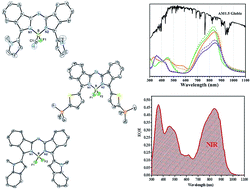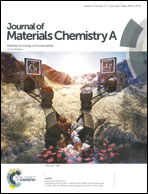Aza-BODIPY dyes with heterocyclic substituents and their derivatives bearing a cyanide co-ligand: NIR donor materials for vacuum-processed solar cells†
Abstract
The need for NIR absorbing materials has become a focus of organic photovoltaics. We synthesize three benzannulated aza-BODIPY dyes with heterocyclic substituents, namely N-methyl pyrrole, N-methyl indole and 2-trimethylsilyl thiophene. With one fluorine atom in the BF2 moiety replaced by a cyano group, three corresponding derivatives are further synthesized. As NIR absorbers, these dyes present high molar extinction coefficients (65 100–104 500 L mol−1 cm−1) in solutions with absorption maxima in the range between 762 and 797 nm. In vacuum-deposited thin films, their absorption bands are further bathochromically shifted peaking from 830 to 849 nm and broadened. CV measurements and theoretical calculations demonstrate that the frontier molecular orbital levels of these compounds are suitable as donor materials in solar cells when combined with C60 as the acceptor. We obtain a PCE of 3.0% and a Voc of 0.61 V, which are rather high values for NIR absorbing vacuum processable small molecular donor compounds, with an absorption onset around 950 nm.

- This article is part of the themed collection: 2017 Journal of Materials Chemistry A HOT Papers


 Please wait while we load your content...
Please wait while we load your content...